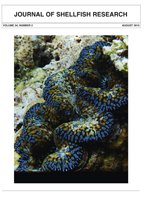Ecosystem services provided by dense populations of filter-feeding bivalves include the potential for sequestration of nutrients acquired by feeding on phytoplankton whose growth is stimulated by urban and suburban nutrient input. Using transplanted oysters, Crassostrea virginica, the potential of using an aquaculture approach to grow, harvest, and therefore remove nitrogen from coastal bays with high nutrient input was studied. Jamaica Bay—urban high nitrogen input (input ∼5.8 × 10s kgN/y)—was contrasted with Great South Bay—suburban and medium nitrogen input (input ∼8.5 × 105 kgN/y)—both located on the south shore of western Long Island, NY. A growth period of June–October was used with a harvest in October as the basis for an estimate, and nitrogen in soft tissues and shell was measured in October, minus the starting values, because both tissue and shell would be removed at the time of harvest. Nitrogen sequestration potential was determined from growth in aquaculture cages, extrapolated to 50% cage coverage over a range of areas in each bay. In the extreme case of total suitable habitat coverage, oysters in Jamaica Bay could extract a total of ∼61% of nitrogen input, and 47% if 5,000 acres were covered; whereas impressive, the oysters could not be sold for food and the cost of such a plan would be prohibitive. In Great South Bay, aquaculture covering 5,000 acres would take up 148% of the nitrogen input, which is encouraging because aquaculture leases are beginning to be awarded in this bay and most waters are clean enough for harvest and human consumption. The results suggest that an aquaculture-based oyster fishery might compensate for the nonpoint source nitrogen input that is common in many estuaries where nitrogen input is moderate and sewer systems are not present.
How to translate text using browser tools
1 August 2015
Using a Shellfish Harvest Strategy to Extract High Nitrogen Inputs in Urban and Suburban Coastal Bays: Practical and Economic Implications
Daria Sebastiano,
Jeffrey S. Levinton,
Michael Doall,
Shauna Kamath
ACCESS THE FULL ARTICLE

Journal of Shellfish Research
Vol. 34 • No. 2
August 2015
Vol. 34 • No. 2
August 2015
Bivalvia
coastal bays
Crassostrea virginica
ecosystem services
nitrogen
nutrient loading
oysters




